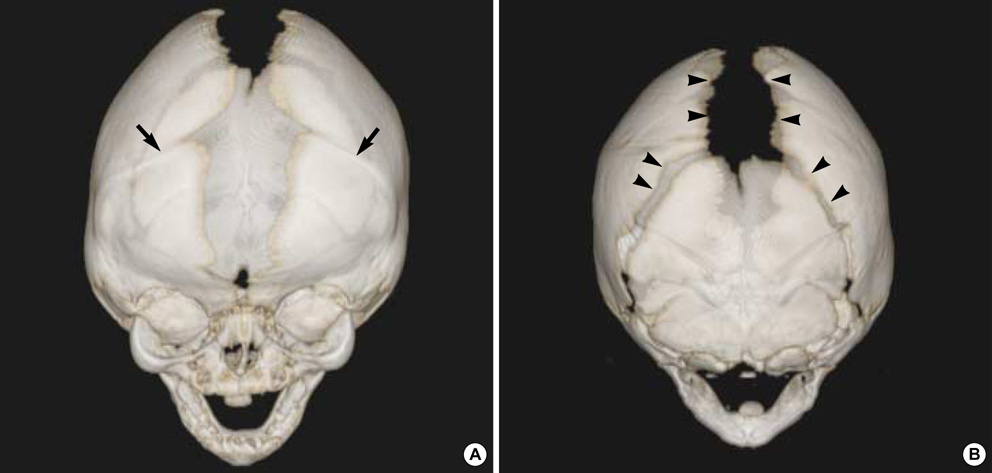J Korean Med Sci.
2006 Apr;21(2):374-378. 10.3346/jkms.2006.21.2.374.
A Case of Pfeiffer Syndrome
- Affiliations
-
- 1Department of Pediatrics, Ajou University School of Medicine, Suwon, Korea.
- 2Department of Plastic and Reconstructive Surgery, Ajou University School of Medicine, Suwon, Korea.
- 3Department of Neurosurgery, Ajou University School of Medicine, Suwon, Korea. ee80@unitel.co.kr
- KMID: 1781856
- DOI: http://doi.org/10.3346/jkms.2006.21.2.374
Abstract
- Pfeiffer Syndrome is as rare as Apert syndrome in the Western population. This condition is very rare in the Asian population and has not been previously reported in Korea. The authors report with a review of literature the case of a newborn baby with Pfeiffer syndrome, manifested by bicoronal craniosynostosis, broad thumbs, and big toes. The infant also had bilateral syndactyly of the fingers and toes, mild proptosis, choanal hypoplasia and maxillary hypoplasia.
Keyword
MeSH Terms
Figure
Cited by 1 articles
-
Pfeiffer Syndrome Type 2 with Sporadic Fibroblast Growth Factor Receptor 2 Mutation and Coccygeal Anomaly
Jin Sun Lee, Jin Hyuk Choi, Yong Wook Lee, Mi Hyeon Gang, Sun Kyoung You, Hyun Dea Shin, Mea-young Chang
Perinatology. 2018;29(3):128-132. doi: 10.14734/PN.2018.29.3.128.
Reference
-
1. Pfeiffer RA. Dominant hereditary acrocephalosyndactylia. Z Kinderheilkd. 1964. 90:301–320.2. Martsolf JT, Cracco JB, Carpenter GG, O'Hara AE. Pfeiffer syndrome: an unusual type of acrocephalosyndactyly with broad thumbs and great toes. Am J Dis Child. 1971. 121:257–262.3. Moore MH, Cantrell SB, Trott JA, David DJ. Pfeiffer syndrome: A clinical review. Cleft Palate-Craniofac J. 1995. 32:62–70.
Article4. Muenke M, Schell U, Hehr A, Robin NH, Losken HW, Schinzel A, Pulleyn LJ, Rutland P, Reardon W, Malcolm S, Winter RM. A common mutation in the fibroblast growth factor receptor 1 gene in Pfeiffer syndrome. Nat Genet. 1994. 8:269–274.
Article5. Robin NH, Scott JA, Arnold JE, Goldstein JA, Shilling BB, Marion RW, Cohen MM Jr. Favorable prognosis for children with Pfeiffer syndrome types 2 and 3: implications for classification. Am J Med Genet. 1998. 75:240–244.
Article6. Schell U, Hehr A, Feldman GJ, Robin NH, Zackai EH, de Die-Smulders C, Viskochil DH, Stewart JM, Wolff G, Ohashi H, Price RA, Cohen MM Jr, Muenke M. Mutations in FGFR1 and FGFR2 cause familial and sporadic Pfeiffer syndrome. Hum Mol Genet. 1995. 4:323–328.
Article7. Teebi AS, Kennedy S, Chun K, Ray PN. Severe and mild phenotypes in Pfeiffer syndrome with splice acceptor mutations in exon IIIc of FGFR2. Am J Med Genet. 2002. 107:43–47.8. Goodrich JT. Albright AL, Pollack IF, Adelson PD, editors. Craniofacial syndromes. Principles and practice of pediatric neurosurgery. 1999. New York: Thieme;243–259.9. Plomp AS, Hamel BC, Cobben JM, Verloes A, Offermans JP, Lajeunie E, Fryns JP, de Die-Smulders CE. Pfeiffer syndrome type 2: further delineation and review of the literature. Am J Med Genet. 1998. 75:245–251.
Article10. Nagase T, Nagase M, Hirose S, Ohmori K. Japanese sisters with Pfeiffer syndrome and achondroplasia: a mutation analysis. J Craniofac Surg. 1998. 9:477–480.11. Sakai N, Tokunaga K, Yamazaki Y, Shida H, Sakata Y, Susami T, Nakakita N, Takato T, Uchinuma E. Sequence analysis of fibroblast growth factor receptor 2 (FGFR2) in Japanese patients with craniosynostosis. J Craniofac Surg. 2001. 12:580–585.
Article12. Cohen MM Jr. Pfeiffer syndrome update, clinical subtypes and guidelines for differential diagnosis. Am J Med Genet. 1993. 45:300–307.
Article13. Goriely A, McVean GA, Rojmyr M, Ingemarsson B, Wilkie AO. Evidence for selective advantage of pathogenic FGFR2 mutations in the male germ line. Science. 2003. 301:643–646.
Article14. Stone P, Trevenen CL, Mitchell I, Rudd N. Congenital tracheal stenosis in Pfeiffer syndrome. Clin Genet. 1990. 38:145–148.
Article15. Vallino-Napoli LD. Audiologic and otologic characteristics of Pfeiffer syndrome. Cleft Palate Craniofac J. 1996. 33:524–529.
Article16. McCarthy JG, Glasberg SB, Cutting CB, Epstein FJ, Grayson BH, Ruff G, Thorne CH, Wisoff J, Zide BM. Twenty-year experience with early surgery for craniosynostosis: II. The craniofacial synostosis syndromes and pansynostosis--results and unsolved problems. Plas Recon Surg. 1995. 96:284–298.17. Wilkie AO, Patey SJ, Kan SH, van den Ouweland AM, Hamel BC. FGFs, their receptors, and human limb malformations: clinical and molecular correlations. Am J Med Genet. 2002. 112:266–278.
Article18. Martsolf JT, Cracco JB, Carpenter GG, O'Hara AE. Pfeiffer syndrome: an unusual type of acrocephalosyndactyly with broad thumbs and great toes. Am J Dis Child. 1971. 121:257–262.19. Panthaki ZJ, Armstrong MB. Hand abnormalities associated with craniofacial syndromes. J Craniofac Surg. 2003. 14:709–712.
Article20. Passos-Bueno MR, Sertie AL, Zatz M, Richieri-Costa A. Pfeiffer mutation in an Apert patient: how wide is the spectrum of variability due to mutations in the FGFR2 gene? Am J Med Genet. 1997. 71:243–245.
Article21. Rutland P, Pulleyn LJ, Reardon W, Baraitser M, Hayward R, Jones B, Malcolm S, Winter RM, Oldridge M, Slaney SF, Poole MD, Wilkie AO. Identical mutations in the FGFR2 gene cause both Pfeiffer and Crouzon syndrome phenotypes. Nature Genet. 1995. 9:173–176.
Article22. Hajihosseini MK, Wilson S, De Moerlooze L, Dickson C. A splicing switch and gain-of-function mutation in FgfR2-IIIc hemizygotes causes Apert/Pfeiffer-syndrome-like phenotypes. Proc Natl Acad Sci USA. 2001. 98:3855–3860.
Article23. Bae SC, Lee EH, Park MS, Hahn SH, Hong CH. A case of FGFR2 exon IIIc mutation in Crouzon syndrome. J Korean Pediatr Soc. 1998. 41:1717–1721.24. Chun K, Teebi AS, Jung JH, Kennedy S, Laframboise R, Meschino WS, Nakabayashi K, Scherer SW, Ray PN, Teshima I. Genetic analysis of patients with the Saethre-Chotzen phenotype. Am J Med Genet. 2002. 110:136–143.
Article25. Gripp KW, Zackai EH, Cohen MM Jr. Clinical and molecular diagnosis should be consistent. Am J Med Genet A. 2003. 121:188–189.
Article
- Full Text Links
- Actions
-
Cited
- CITED
-
- Close
- Share
- Similar articles
-
- Pfeiffer Syndrome
- A case of Pfeiffer syndrome with c833_834GC>TG (Cys278Leu) mutation in the FGFR2 gene
- A Case of Pfeiffer Syndrome with Hydrocephalus and Multiple Congenital Anomalies
- A Case Report of Pfeiffer Syndrome with Spinal Anomaly
- Pfeiffer Syndrome Type 2 with Sporadic Fibroblast Growth Factor Receptor 2 Mutation and Coccygeal Anomaly





